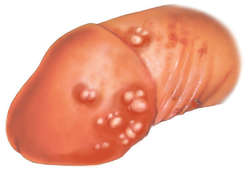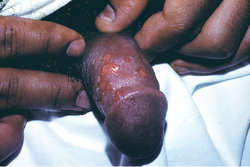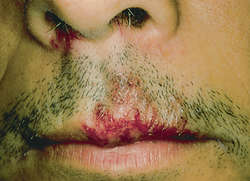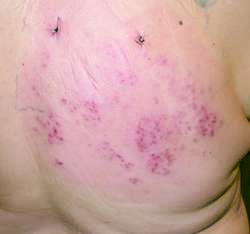Medical term:
Herpes
herpes
[her´pēz]The incidence of active genital herpes is difficult to determine precisely because many cases present mild symptoms, are self-limiting, and are not called to the attention of health care personnel. However, it is clear that the disease has reached epidemic proportions in the United States. It is highly contagious and is transmitted by direct person-to-person contact (not limited to sexual contact). Autoinoculation via the hands is possible; for example, from a lip ulcer to the genital area or from the lip or genitals to the eye. Once the virus gains access to the body it enters the nervous system and invades nerve cells located near the site of infection, such as in the sacral ganglia. The virus lies dormant in nerve cells and can remain there indefinitely, predisposing the person to recurrent outbreaks. Factors contributing to recurrent genital herpes are not well understood. Some infected persons experience no recurrences while others have frequent and severe outbreaks. Many patients are aware of a correlation between the appearance of lesions and precipitating factors such as exposure to sunlight, local trauma, fever, or emotional stress. Hormonal changes preceding menses have been associated with recurrences in women.
Typically, recurrent episodes become milder and less frequent; however, some patients may experience weekly or monthly outbreaks that are severe and painful. Those with recurrent herpes usually have high antibody titers. Paradoxically, it has been noted that the higher the antibody titer the more severe the symptoms and the more frequent the recurrences. Thus, it is apparent that the body's immune system is not effective in providing protection against herpes infection or in mitigating its effects.
A genital rash and mild itching usually are the earliest signs of infection. Eventually vesicles on the surface of the skin form, and then enlarge, break open, and ulcerate. The lesions are painful, especially during coitus, and can cause intense itching, and, if the urethra is involved, painful urination. The disease affects both sexes. In the male, vesicles are found principally on the glans penis, shaft of the penis, and prepuce, and may extend to the scrotum and inner thighs. In the female, vesicular eruptions usually involve the vulva, vagina, and cervix, and may extend to the perineum, inner thighs, and buttocks. Lesions of the cervix can vary from small superficial ulcers with diffuse inflammation to a single, large, necrotic ulcer. Other symptoms include malaise, fever, and anorexia. There also can be involvement of neural structures and the manifestation of neurologic symptoms. The characteristic lesions usually last from one to three weeks in either the initial stage or during periodic outbreaks.
Support groups can provide patients opportunities to ventilate their anger and talk about their guilt. In a group of persons with similar problems, they can learn that there are others who have had much the same feelings and have managed to work through them and develop a more positive attitude. The American Social Health Association (ASHA) sponsors self-help groups and provides educational materials; their address is P.O. Box 13827, Research Triangle Park, NC 27709.
Fear of cancer is very real in these patients; females are encouraged to have a Pap smear every six months. Early detection is almost guaranteed with such frequent examinations, and the cure rate in these cases is 100 per cent. Another source of anxiety for female patients is the effect of herpes on fertility and the welfare of infants born of mothers with herpes (see maternal herpes).
Protective measures such as cesarean section for delivery improve the chances of avoiding infection in the newborn. During the last trimester it is best if the woman abstains from sexual intercourse if there is any history of either partner having herpes. When there is such a history, it is recommended that frequent cervical viral cultures be done to determine whether vaginal delivery is safe.
With early diagnosis and cesarean section many infants can be protected from infection, but only if the membranes are intact or have been ruptured no more than 4 to 6 hours before the operation. After that length of time it is assumed that an ascending infection has reached the fetus. Mothers who have no active lesions at the time of birth and two negative cervical smears for the virus within a week of delivery can safely deliver their newborns vaginally.
Wound and skin precautions are followed in the care of the mother if she has recurrent herpes (see above). An isolation nursery and wound/skin precautions are recommended for newborns delivered (whether vaginally or by cesarean section) to women with active genital herpes. Some authorities recommend isolation precautions the entire time the newborn is in the hospital and until the incubation period of 21 days has passed.
Treatment is symptomatic and is aimed at relieving the pain and itching of the blisters. Local applications of calamine lotion or other lotions to dry the blisters may help. Herpes zoster is a very exhausting disease, especially for elderly people, because the constant itching and pain are difficult to control, even with systemic analgesics in some cases.
Herpes zoster affecting the eye causes severe conjunctivitis and possible ulceration and scarring of the cornea if not treated successfully.
Herpes zoster is a communicable disease and therefore requires some type of isolation, the specific precautions depending on whether the disease is localized or disseminated and also on the condition of the patient. Localized lesions in immunocompromised patients often become disseminated. Persons susceptible to varicella-zoster (chickenpox) should stay out of the patient's room. This includes hospital personnel as well as other patients. If there is any question as to the proper procedures for prevention of the spread of herpes zoster, the CDC Guidelines for Infection Control in Hospital Personnel should be consulted.
her·pes
(her'pēz),herpes
(hûr′pēz)her·pes
(hĕrpēz)Synonym(s): serpigo (2) .
herpes
(her'pez? ) [Gr. herpes, creeping]herpes corneae
herpes facialis
herpes febrilis


genital herpes
Symptoms
Patients often experience local pain, itching, burning, dysuria, or other uncomfortable sensations that sometimes begin before a rash or lesion(s) appears on the skin. The skin lesion consists of a reddened patch or small blisters (vesicles) or pustules that ulcerate before healing. These typically take about 10 days to heal. Regional lymph nodes often enlarge and become tender. Systemic symptoms (e.g., fever and malaise) sometimes accompany the initial outbreak or recurrences. However, asymptomatic shedding of the virus is common and may represent the most common way in which the virus is transmitted from person to person.
Potential Complications
Genital herpes may be transmitted to the newborn during childbirth and may cause serious complications, including respiratory illnesses, retinal infection, liver infection, encephalitis, mental retardation, blindness, deafness, seizures, microcephaly, and diabetes insipidus. Cesarean delivery or maternal suppression of the virus with acyclovir are two methods used to prevent newborn infection. Poor hand hygiene may transmit the virus to the eye(s), resulting in herpetic keratoconjunctivitis.
Treatment
Oral acyclovir or its derivatives can treat both the initial outbreak and subsequent recurrences and diminish asymptomatic viral shedding.
CAUTION!
Herpetic lesions are contagious, and those caring for the patient must avoid contact with the exudates. Wearing gloves when in contact with mucous membranes, followed by good hand hygiene helps health care professionals prevent herpetic whitlow (finger infections).Patient care
The patient should be taught to avoid all skin-to-skin contact when lesions are present and to practice safe sex. Patients should not share towels or other personal care items. Patients with genital herpes often experience anger, self-doubt, fear, or guilt, esp. at the time of initial diagnosis or during recurrences. Counseling and support may help the patient address these issues. Patient education improves understanding of the prevalence of the disease in the general population, the recurring nature of the eruption, safe sexual practices, medication use, and psychosocial and relationship issues.
herpes gestationis

herpes labialis
herpes menstrualis
ocular herpes
herpes simplex
traumatic herpes


herpes zoster
The incubation period is from 7 to 21 days. The total duration of the disease from onset to complete recovery varies from 10 days to 5 weeks. If all the vesicles appear within 24 hr, the total duration is usually short. In general, the disease lasts longer in adults than in children. It is estimated that about 50% of people who live to age 80 will have an attack of herpes zoster. This infection is more common in persons with a compromised immune system: older adults, those with AIDS or illnesses such as Hodgkin's disease and diabetes, those taking corticosteroids, or those undergoing cancer chemotherapy.
Pain often develops along affected skin and persists for months after resolution of the rash. This discomfort, which may be severe in patients older than 50, is known as postherpetic neuralgia. It may intensify at night or worsen when clothes rub against the skin. Synonym: shinglesillustration; herpes zoster ophthalmicus;
Diagnosis
Diagnosis is usually made based on clinical assessment. If further studies are required, the CDC recommends direct fluorescent antibody testing of specimens collected by rubbing a swab on the base of an open lesion.
Treatment
In healthy adults, acyclovir, famciclovir, and valacyclovir are effective in reducing viral shedding and nerve pain damage if administered within 3 days of onset of the rash. Corticosteroids, gabapentin, pregabalin, nonsteroidal anti-inflammatory drugs, some antidepressants, and narcotics may decrease the pain of postherpetic neuralgia. Itching may be reduced with colloidal oatmeal or other topical treatments. Capsaicin cream (an extract of hot chili peppers) may be applied topically for pain relief, but this should be done only after active lesions have subsided.
Patient care
The prescribed antiviral agent is administered and explained to the patient, along with information about desired and adverse effects. Skin lesions are inspected daily for signs of healing or secondary infection; the patient's response to treatment is evaluated regularly, and he is monitored for associated complications. Prescribed analgesics are given on a schedule to minimize neuralgic pain. Patients experiencing neuralgia following the acute stage of the disease should be referred for ongoing therapy. He is reassured that HSV pain will subside eventually, that the prognosis for complete recovery is good, and that the infection seldom recurs.
prevention
Reactivation of varicella zoster virus (VZV) may be prevented with a vaccine. VZV vaccination is approved for use in the U.S. in adults at age 60.

herpes zoster ophthalmicus
herpes zoster oticus
Ramsay Hunt syndrome.Herpes
her·pes
(hĕrpēz)Patient discussion about herpes
Q. Where are good places to go for true info an treatmeant for herpes genital an non genital?
Q. i have genital herpes ...i got it from ex boyfriend is there a natural cure that you know of? i've had 2 breakout in a year and a half
Q. Are cold sores contagious? My boyfriend has cold sores on his mouth. Can I catch it from him? If so, how can I prevent catching it?
Latest Searches:
Pyrazinamide - isoniazid - Rifampicin - isoniazid - Lopevi - lopedium - antiodontalgic - antimutagenic - antimongolism - antimitotic - antimetabolites - antilogous - antileishmanial - antihelmintic - antifibrotic - antiendotoxin - anticoagulative - anticoagulant - anticholelithogenic - antiasthmatics -
- Service manuals - MBI Corp